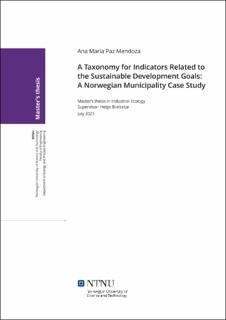| dc.description.abstract | Global conditions are pushing cities and municipalities to a deeper involvement in sustainability. The 2030 Agenda contributes as a framework for multi-level stakeholders to
aim for the Sustainable Development Goals. In efforts to track progress on sustainability, municipalities in Norway have used international indicator sets such as the U4SSC
KPIs to track such progress. Although several international sustainability indicator sets
provide information on progress and allow tracking, concerns from municipalities have
raised in the inability to localize indicators for their municipalities. In 2021 a taxonomy
for indicators related to the SDGs has been published to aid in such issue. To understand whether this taxonomy can enable municipalities in localizing indicators and be
integrated into their strategies, a case study with 4 Norwegian municipalities was carried
out through semi-structured interviews to analyze first-hand information on its application. An analysis of these interviews yields the taxonomy is not as intuitive as desired,
however, it is a tool that proposes good questioning and classification methods to discuss and define whether indicators analyzed are appropriate and can contribute to the
municipality’s future plans and strategies. | |
